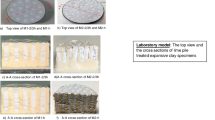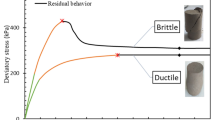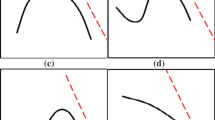Abstract
Lime stabilization is an effective way of stabilizing expansive clays, which cause significant environmental problems both as earth and foundation materials. There are considerable environmental benefits in using the in situ lime-stabilized expansive soils in the construction of road pavements, fill or foundations instead of importing valuable granular materials. However, due to high plastic nature of these clays, achieving appropriate pulverization in field applications is a difficult task. This paper presents the results of a laboratory investigation to determine the effects of soil pulverization quality on lime stabilization of a local expansive clay. Effect of mellowing the soil–lime mixtures for 24 h was also studied to find out whether this would compensate for poor pulverization. The clay studied had swelling pressures varying between 300 and 500 kN/m2 and free swell potential as high as 19%. In this study, 3, 6 and 9% lime by dry weight were used for lime-stabilized samples. Unconfined compression strength, failure strain and Secant Elasticity Modulus values were measured through unconfined compression strength testing. The results of the study showed that lime stabilization improved plasticity, workability, compressive strength, elastic moduli and swelling and compressibility behavior of the expansive clay. While mellowing did not have a definite effect on the measured strength and moduli values, soil pulverization quality considerably affected the unconfined compression strength and Secant Elasticity Modulus values. The higher the percentage passing No. 4 sieve, the higher the effectiveness of lime treatment. Based on the data obtained in this study, two original equations were derived to assign Secant Elasticity Modulus based on unconfined compression strength, for different soil pulverization qualities. Microfabric investigations conducted by Environmental Scanning Electron Microscope and Mercury Intrusion Porosimetry exposed the effect of lime stabilization on fabric, porosity and pore size distributions. The results of the study clearly demonstrated that if enough time and effort were not given to soil pulverization process in lime stabilization works in field applications, lower performance and therefore increased environmental problems should be expected.


















Similar content being viewed by others
References
ASTM D2166-06 (2006) Standard test method for unconfined compressive strength of cohesive soil. ASTM International, West Conshohocken
ASTM D421-85 (2007) Standard test method for dry preparation of soil samples for particle size analysis and determination of soil constants. ASTM International, West Conshohocken
ASTM D422-63 (2007) Standard test method for particle size analysis of soils. ASTM International, West Conshohocken
ASTM D4318-05 (2005) Standard test method for liquid limit, plastic limit and plasticity index of soils. ASTM International, West Conshohocken
ASTM D854-06 (2006) Standard test method for specific gravity of soil solids by water pycnometer. ASTM International, West Conshohocken
Basma AA, Tuncer ER (1991) Effect of lime on volume change and compressibility of expansive clays. Transportation Research Record No. 1295, pp 52–61
Eades JL, Grim RE (1966) A quick test to determine lime requirements for lime stabilization. Highway Research. Record 139
Garaisayev S (2008) Chemical stabilization of expansive soils. M.Sc. thesis, Institute of Sciences, Istanbul University, 170 p (in Turkish)
Jones DR, Holtz WG (1973) Expansive soils—the hidden disaster. Civ Eng 43:49–51
Kavak A, Akyarli A (2007) A field application for lime stabilization. Environ Geol 51(6):987–997
Little DN (1991) X Ray Diffraction, energy dispersive spectra and scanning electron microscopic evaluation of stabilized Denver clay soils containing sulfates. Report to Chemical Lime Company, Fort Worth, Texas
Little DN (1995) Handbook for stabilization pavement subgrades and base courses with lime, prepared for APG lime company. Hunt Publishing Company, Kendal
Little DN (1999) Evaluation of structural properties of lime stabilized soils and aggregates, vol 1. Summary and findings. Prepared for National Lime Association
Locat J, Bérube MA, Choquette M (1990) Laboratory investigation on the lime stabilization of sensitive clays: shear strength development. Can Geotechnol J 27:294–304
Mitchell JK, Soga K (2005) Fundamentals of soil behavior, 3rd edn. Wiley, New York
Muller CJ (2005) Pozzolanic activity of natural clay minerals with respect to environmental geotechnics. Doctor of Technical Science, Swiss Federal Institute of Technology, Zurich
Nalbantoğlu Z, Tuncer ER (2001) Compressibility and hydraulic conductivity of a chemically treated expansive clay. Can Geotechnol J 38:154–160
Ozgul N et al (2005) General geology of Istanbul City, Istanbul Municipality (in Turkish)
Petry TM, Little DN (2002) Review of stabilization of clays and expansive soils in pavements and lightly loaded structures—History, practice and future. ASCE J Mater Eng 14(6):447–460
Petry TM, Wohlegemuth SK (1988) Effects of pulverization on the strength and durability of highly active clay soils stabilized with lime and Portland cement, Transportation Research Board 1190, 0-309-04758-7, pp 38–45
Rajasekaran GR, Rao Narasimha SN (2002) Permeability characteristics of lime treated marine clay. Ocean Eng 29:113–127
Seed HB, Woodward RJ, Lundgren R (1962) Prediction of swelling potential for compacted clays. J Soil Mech Found Div Am Soc Civ Eng 88(SM3)
Sherwood PT (1993) Soil stabilization with cement and lime, Transport Research Laboratory, State of the art review. HMSO
Thompson, MR (1966) Shear strength and elastic properties of lime soil mixtures. Transportation Research Record No. 139
Tonoz M, Gokceoglu C, Ulusay R (2003) A laboratory-scale experimental investigation on the performance of lime columns in expansive Ankara (Turkey) clay. Bull Eng Geol Environ 62(2):91–106
TS EN 1744-1 (2000) Tests for chemical properties of aggregates—Part 1: Chemical analysis, Institute of Turkish Standards
UFC Unified Facilities Criteria (2004) Foundations in expansive soils, US Army Corps of Engineers, UFC-3-220-07
Wild S, Arabi M, Rowlands GO (1987) Relation between pore size distribution, permeability, and cementitous gel formation in cured clay–lime systems. Mater Sci Technol 3:1005–1011
Acknowledgments
This study was supported by Research Fund of the Istanbul University, Project Number: 2128.
Author information
Authors and Affiliations
Corresponding author
Rights and permissions
About this article
Cite this article
Bozbey, I., Garaisayev, S. Effects of soil pulverization quality on lime stabilization of an expansive clay. Environ Earth Sci 60, 1137–1151 (2010). https://doi.org/10.1007/s12665-009-0256-5
Received:
Accepted:
Published:
Issue Date:
DOI: https://doi.org/10.1007/s12665-009-0256-5




